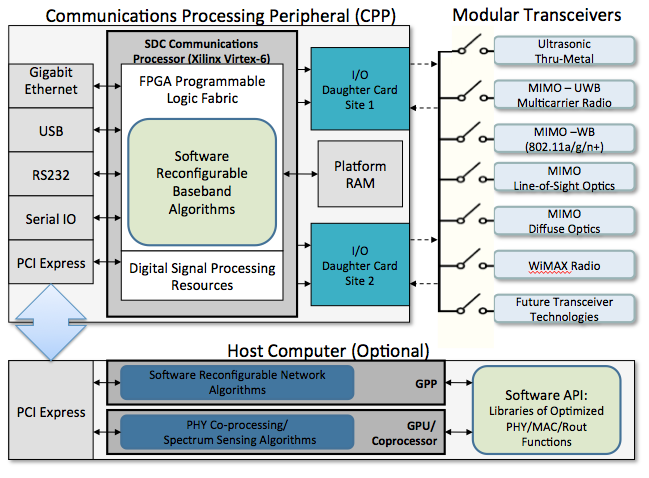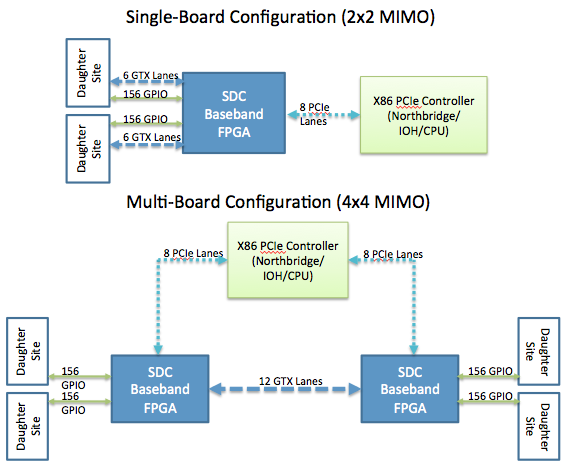Lab Software Defined Communications (SDC) Testbed
Two prominent examples of SDR in the academic community are the GNU USRP/USRP2 SDR and the Wireless Open-Access Research Platform (WARP) testbed. Multiple nodes of both GNU radio and WARP are available in our laboratory for evaluation and development of software defined radio networks, as is the HYDRA testbed developed in collaboration with the University of Texas at Austin. However, the majority of SDR platforms that are widely available to the academic and industrial research community have several notable limitations, including:
- Sampling rates and processing capabilities limited so that systems are predominantly limited to IEEE802.11 data rate
- Lack of available FPGA fabric and programming flexibility to allow implementation of newest algorithms proposed by the communications and signal processing community
- Exclusive focus on radio-frequency based communications
To address these limitations, using funding from NSF (CNS #0923003 and CNS #0854946), DWSL is developing a “Software Defined Communication” (SDC) Testbed 1 for release to the wireless academic and industrial research community. The SDC Testbed seeks to provide a research and development platform capable of designing and prototyping next generation wireless communication standards which make use of radio, optical, and ultrasonic communication modalities. The vision for this platform builds on the current principles of SDR. Specifically, it extends this concept through utilization of propagation media beyond the RF spectrum while meeting the high bandwidth demands of emerging communications standards. The project will provide an open source tool for both the commercial and academic wireless research communities. Furthermore, it is designed to provide a cohesive and affordable hardware/software infrastructure for fast and flexible algorithm development across multiple layers of the communication stack.

Some of the key features of the Drexel SDC Testbed are described below:
Scalable OFDM - While many FPGA-based real-time SDR platforms claim to be reconfigurable in software, the reality is that these systems are often limited to consider minor modifications of an existing wireless protocol. To address this limitation, DWSL has developed a scalable, programmable implementation of the physical layer for wireless communication systems that use orthogonal frequency division multiplexing (OFDM) schemes. Specifically, we have designed a scalable OFDM pipeline comprising codec, modulation, interleaving, piloting, and IFFT stages in which each stage can be configured at design time or at run time to accommodate different standards as well as different configuration settings for a single standard. This flexibility is achieved by designing the overall pipeline to be insensitive to the latencies incurred by individual stages. With this system, the capability exists to prototype different OFDM based standards (e.g., 802.11, WiMAX, ECMA-368) as well as consider OFDMA and noncontiguous OFDM based systems.
Ultrawideband SDR - The Drexel SDC is designed to operate with GHz sampling rates. It makes use of a Virtex 6 FPGA evaluation board based design that can evolve with future developments in FPGAs. Using the scalable OFDM implementation described above, the Drexel SDC can be used to rapidly prototype, characterize, and develop future standards based upon UWB OFDM and UWB MIMO OFDM based technologies. Modular front-end transceiver blocks are under construction to not only implement RF UWB standards, but also to apply this code towards the rapid prototyping of free space optical systems.
Cross modality networking - Transceivers have been constructed to generalize what is meant by software defined radio to include communication modalities other than RF, namely ultrasound and free space optics (FSO). The testbed has been used to implement single modality ultrasonic and diffuse FSO communication links and has also been used to construct hybrid networks that make coordinated use of multiple modalities simultaneously for specialized local area networking applications. DWSL has applied MIMO techniques, typically used in the RF domain, in the optical domain to overcome power limitations and increase the spectral capacity and data rate in diffuse optical communication links. We have demonstrated, for the first time experimentally, the real time implementation of diffuse free space optical communication links. Similarly, while ultrasound has been used extensively for biomedical and sonar applications, there is increased interest in using ultrasonic communications for military applications where other communication modalities would be impractical. Using support from the Office of Naval Research (ONR), we have demonstrated how ultrasonic communication links, rapidly prototyped through SDR (and leveraging techniques developed for RF applications) can be used to enhance thru-hull networking onboard naval vessels.

DWSL SDR field testing activities rely heavily on field experimentation. In addition to the on-site tactical networking field experiments discussed earlier, through funding from the NSF GENI WiMAX program2 through NSF CNS #1138949, DWSL is working to deploy a WiMAX cell tower on Drexel campus to provide wireless connectivity to the campus and local community. This basestation tower will provide remote research capabilities to off campus users through the NSF GENI WiMAX program.
visit http://wireless.ece.drexel.edu/sdc for more information↩︎